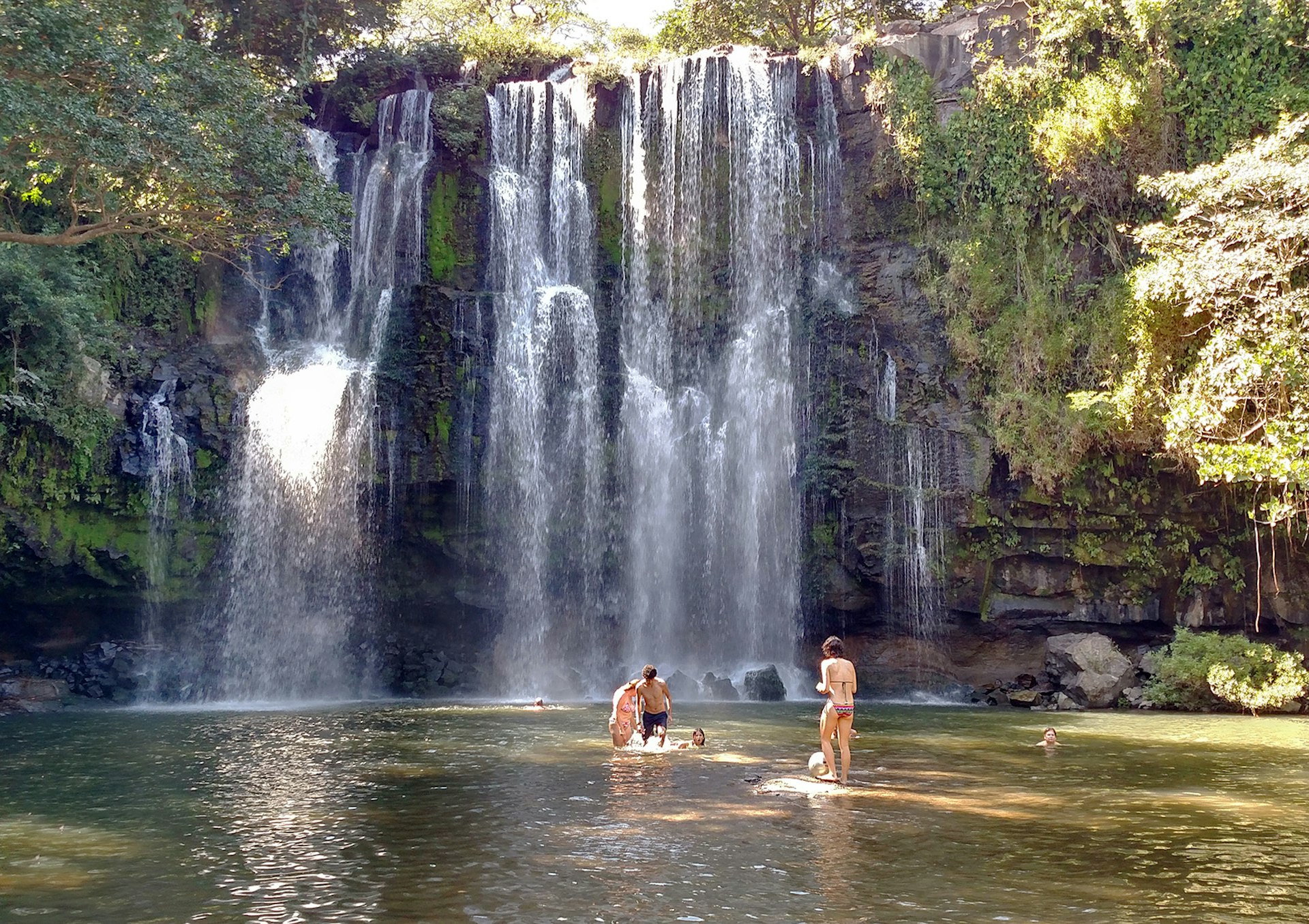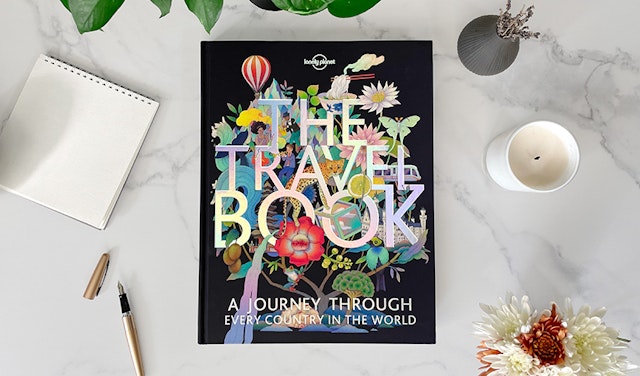Costa Rica is the easy way to dive into Central America with kids in tow. Its rainforests, beaches and volcanoes are legendary, and the tourist industry goes out of its way to make things easy for visitors, putting all these natural wonders within reach of even the youngest and most inexperienced travelers.
For families, Costa Rica is one big – and famously safe – playground for tropical adventures. Whether your tastes run to building sandcastles on palm-backed beaches, or white-water rafting down surging jungle rivers, you'll find family fun at every turn, often with an environmentally friendly angle. And the rainforests of Costa Rica serve up easy wildlife encounters with everything from sloths and coatis to hummingbirds and toucans.
It's fair to ask if all the action and adventure in this little dynamo of a country will overwhelm small travelers, but Costa Rica is incredibly child-friendly and will spark a love of the outdoors for kids of all ages. Here are our tips for a perfect family trip to this Central American wonder.
Is Costa Rica good for kids?
The perfect stop in Central America for family travel, Costa Rica is a safe, exhilarating tropical playground that will make a huge impression on younger travelers. The country’s myriad adventures cover the whole spectrum of intensity levels, from gentle adventures for tots to adrenaline thrills for teens. And for no intensity at all, the kids can always sit on the sand and get their hair braided and beaded by a beachside stylist in Puerto Viejo de Talamanca.
Whatever you do, Costa Rican culture is extremely welcoming to little ones, and the country is regularly cited as the most peaceful country in all of Central America and the Caribbean. The usual travel risks do exist, of course, but in general, traveling here is a more relaxed experience than in most of Costa Rica's neighbors. The key danger families should be aware of is rip tides on Costa Rica's beaches – seek local advice before letting the kids dive in.
In addition to amazing the kids, this small country is easy to explore, with great country-wide transportation infrastructure and an excellent health-care system. However, if you plan to rent a car, bring your own infant car seat; even if the rental agency has one available, it may not be in a good state of repair.
Children's menus aren't common in restaurants and it may be wise to book accommodation with kitchen facilities if your little Marco Polos are particularly picky eaters. Discounts for kids under 12 are available at many attractions and on public transport – always ask if you're not sure.

Best things to do in Costa Rica with kids
With such a stellar array of experiences and wild encounters in Costa Rica – meeting the wildlife, riding the surf, whooshing along ziplines, climbing volcanoes – the biggest challenge might be choosing which amazing national park to visit next. Fortunately, each region has its own attractions, and kids of all ages will find epic adventures awaiting them in every corner of the country.
Canopy tours
Costa Rica's rainforests are some of the most stunning areas of virgin jungle in the world, but navigating on foot can be hot, damp and uncomfortable, and much of the wildlife lives at the top of the canopy. To get a bird’s-eye view, ride one of Costa Rica's impressive zip-lines through the lush greenery.
The country’s first zip-line, the Original Canopy Tour, is in Monteverde, northwest of San José, but nowadays there are canopy tours all over the country. Note that not all zip-lines can accommodate smaller children (under 4ft or six years old), but some do, including Selvatura and Arenal Paraíso Canopy Tour. Kids can zip across the cables while attached to a guide, so they don’t have to worry about controlling their own speed.
Of course, some people, no matter what age, are a little wary of zooming over the forest at high speeds suspended from a wire – go figure. In this case, canopy walkways (sometimes described as 'hanging bridges') are a better option for exploring the rainforest at your own pace.
Sky Adventures, Selvatura and Mistico all have dangling bridge options. Again, some facilities are better than others for very small children – inquire if there is a gap between the walkway and the guardrail on the bridges to gauge suitability for younger kids.

River rafting
Is there a small adrenaline junkie in the family? Kids as young as six or seven years old can ride river rapids with the correct safety gear (provided by rafting operators), and even smaller children can get out on the river on a 'safari float' on gentler river courses. These stick to mild Class I and II rapids and allow time for a swim and snack break – both Aventuras del Sarapiquí near La Virgen and Safaris Corobicí near Cañas offer kid-friendly rafting experiences. Tubing is another big hit on calmer stretches of river.

Swimming in waterfalls
There’s something about bathing under a waterfall that’s uplifting for body and soul. If you have kids in tow, the trick is to find a cascade that is safe for swimming and does not require a strenuous hike to reach, and Costa Rica has plenty.
A well-maintained, 2km (1.2-mile) hiking trail starts behind the Arenal Observatory Lodge in Parque Nacional Volcán Arenal, leading to a stunning waterfall that's great for a family splash, though swimming here is best avoided if water levels are high.
Near Bagaces, Llanos de Cortés is another easily accessible and spectacularly beautiful waterfall with a picture-perfect swimming hole. More adventurous (or slightly older) kids may be up for the trip to the Montezuma Waterfalls or the Catarata Río Fortuna.

Easy wildlife watching
Wildlife watching can be tricky with kids, as you never know what you will (or won’t) see, but Costa Rica has plenty of wild spots where you'll definitely see something exotic. We recommend taking a wildlife cruise because a boat ride is an adventure in itself, even if the animals are feeling shy that day. Take a boat tour at Refugio Nacional de Vida Silvestre Caño Negro or cruise the canals in the Parque Nacional Tortuguero, and you will see something – birds, iguanas, monkeys, sloths or even a few caimans.
If your timing is right, you might witness a mother turtle hauling herself up on the beach to lay her eggs on one of Costa Rica's beaches, an incredible experience for travelers of all ages. The arribada (mass arrival) of olive ridley turtles at Playa Ostional from July to December is especially impressive, though you can take turtle tours up and down both coasts. These animals are endangered, so be sure to book tours with responsible service providers who use licensed guides.
If you are looking for a fail-safe wildlife option, visit a rescue center. Many offer safe and ethical opportunities for kids to get a close look at nature, including the Jaguar Centro de Rescate south of Puerto Viejo de Talamanca, Proyecto Asis in Ciudad Quesada (San Carlos) and Alturas Animal Sanctuary in Dominical. These centers do great work to converse endangered wildlife, and a visit is a great way to show the benefits of conservation to the next generation.

Surfing Costa Rica's beaches
There are surf beaches on both of Costa Rica's tropical shorelines, and different weather conditions on the Caribbean and Pacific coasts ensure plenty of variety. Most surf schools give lessons to children as young as 5 years old, and some cater especially well for families, including Safari Surf in Nosara, Matos Surf Shop in Tamarindo and Playa Grande, and One Love Surf School in Puerto Viejo de Talamanca. Alternatively, skip the lessons and rent a boogie board on the beach at Playa Sámara and your kids will be riding the waves on their bellies in no time.

Volcanoes and hot springs
Budding geologists will get a kick out of peering into the crater of a volcano at Parque Nacional Volcán Poás (which is wheelchair accessible, so it's also stroller accessible). You can see other volcanic activity – bubbling mud pots and the like – at the Pailas Sector of Parque Nacional Rincón de la Vieja or at Las Hornillas near Volcán Miravalles.
Finally, here’s one geothermal activity that travelers of all ages can get excited about: hot springs! You’ll find appealing springs for a soak near Miravalles (Río Perdido, Termales El Guayacán) and Rincón de la Vieja (Canyon de la Vieja, Hot Springs Río Negro), but the most elaborate thermal pools are around La Fortuna, including fancy set-ups such as The Springs or more understated environs such as Eco Termales.
Accommodation
Even your lodging is an opportunity for a family adventure in Costa Rica. Beach resorts abound, as do unique eco-resorts where you can spend the night amidst tropical greenery and chirruping jungle insects.
Stay on a farm
Agrotourism allows guests to experience authentic, rural life in Costa Rica. Kids can help take care of farm animals, observe the sugar cane harvest and learn about sustainable farming practices at centers such as the eco-focused Finca Terra Viva and Capulín Cabinas & Farm, two excellent choices near Santa Elena.
The Río Celeste area also offers many options for farm living, including the appealing La Carolina Lodge. Horseback riding is a specialty at Rancho Margot in El Castillo and Rancho Amalia near Zarcero. Other great, budget-friendly farm stays include Finca La Flor near Cartago, Punta Mona south of Manzanillo, and the truly special Albergue el Socorro near San Miguel.

Sleep in a tent
Some call it 'glamping’ while others just call it sustainable tourism! Costa Rica has no shortage of semi-permanent camps with heavy-duty tents that offer (almost) all the comforts of a permanent structure, without the same environmental impact, and kids will love feeling the breeze and hearing the noises of the jungle from the comfort of their beds.
Rafiki Safari Lodge near Quepos is surrounded by rainforest and river ecosystems, while Corcovado Adventures Tent Camp near Drake Bay and La Leona Eco Lodge near Carate have prime beachfront locations on the edge of Parque Nacional Corcovado.
Climb into a tree house
Kids will be in their element in Costa Rica's awesome treetop hideaways. Birds, monkeys, and other tree-climbing creatures come calling at the Tree Houses Hotel near San Carlos and the Tree House Lodge near Puerto Viejo de Talamanca. There are all sorts of family-friendly accommodations – including tree houses – at Posada Andrea Cristina in Puerto Viejo de Sarapiquí and Flutterby House in Uvita.

Best meals for kids in Costa Rica
There are only three words you need to know to keep your kid well-fed in Costa Rica – rice and beans. With simple flavors and mild spices, the local cuisine is generally kid-friendly, with plenty of foods that are accessible to young palates.
Gallo pinto
The national dish of Costa Rica is, you guessed it, rice and beans. It’s actually a breakfast item, served alongside eggs or cheese. And if your child wants to eat it every day, they won’t be alone – plenty of locals do too.
Casado
This typical set lunch consists of meat or chicken, salad and, you guessed it, rice and beans. It’s simple, tasty and filling. If your child is really lucky, there might be plátanos maduros – sweet hunks of fried ripe plantain – on the side.
Patacones
The favorite local way of eating plantains, patacones are a local staple. Thick slices of green plantain are fried, squashed, and fried again, then served with beans or guacamole.
Batidos
Batidos, or jugos naturales, are fresh fruit smoothies, made with banana, mango, pineapple, papaya, watermelon, or just about any other fruit. One batido guarantees a day’s worth of Vitamin C – ask for it made con leche (with milk) and you’ve got your kid’s calcium intake covered too.


